Graduate Consultant Report: TDABC Suitability for TPG Telecom Ltd.
VerifiedAdded on 2021/06/14
|12
|3046
|22
Report
AI Summary
This report, prepared by a graduate consultant, evaluates the suitability of the Time-Driven Activity-Based Costing (TDABC) system for TPG Telecom. Commissioned by a client evaluating the company's budgeting, the report provides a detailed overview of TDABC, including its characteristics, distinctions from traditional and activity-based costing, and case studies demonstrating its successful implementation in various organizations. The report examines the benefits and drawbacks of TDABC, considering time and cost drivers to determine product costs. The consultant concludes that TDABC is appropriate for TPG Telecom, recommending its adoption to improve budgeting, increase profitability, and enhance customer relationships, ultimately contributing to the company's growth in the telecommunications industry.
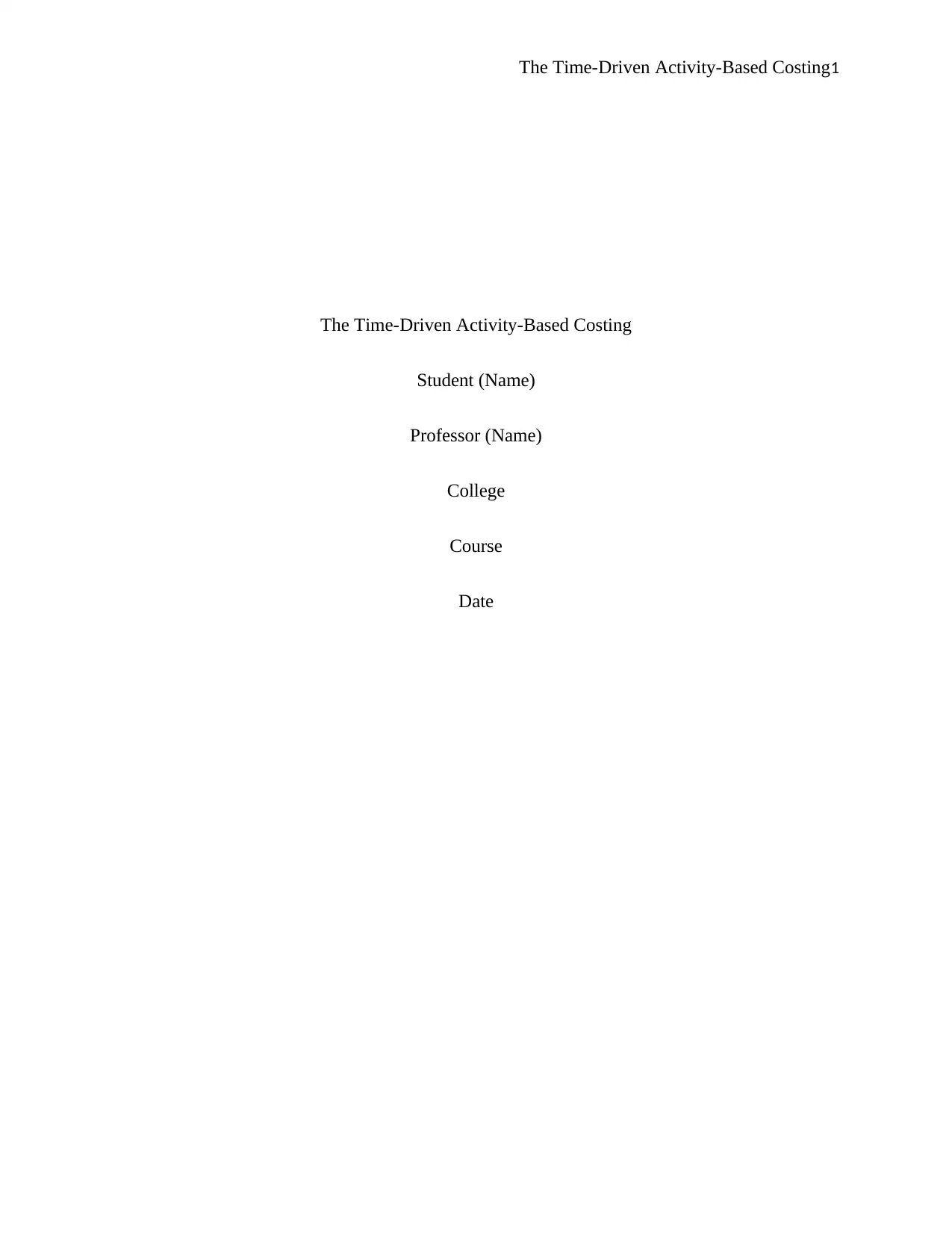
The Time-Driven Activity-Based Costing1
The Time-Driven Activity-Based Costing
Student (Name)
Professor (Name)
College
Course
Date
The Time-Driven Activity-Based Costing
Student (Name)
Professor (Name)
College
Course
Date
Paraphrase This Document
Need a fresh take? Get an instant paraphrase of this document with our AI Paraphraser
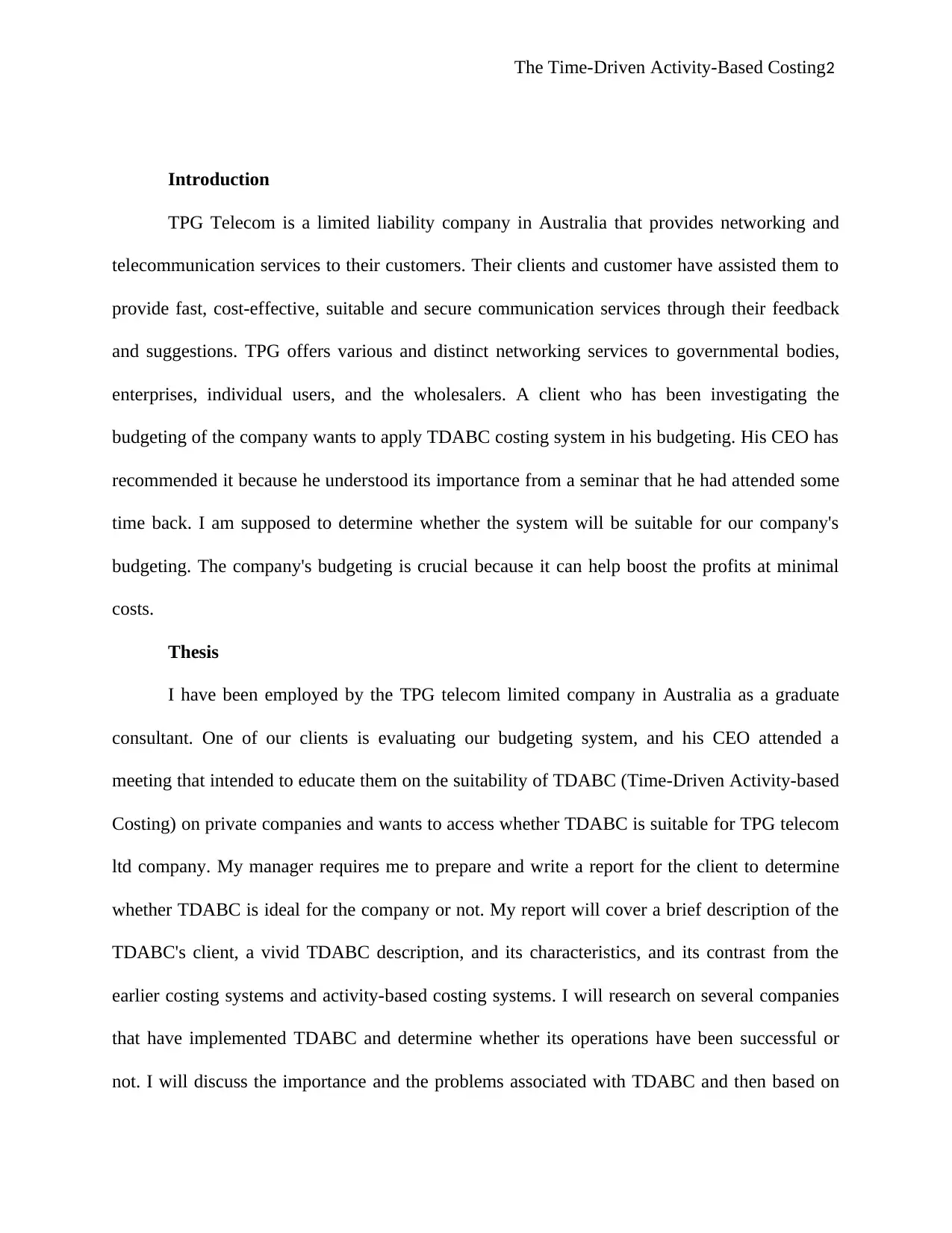
The Time-Driven Activity-Based Costing2
Introduction
TPG Telecom is a limited liability company in Australia that provides networking and
telecommunication services to their customers. Their clients and customer have assisted them to
provide fast, cost-effective, suitable and secure communication services through their feedback
and suggestions. TPG offers various and distinct networking services to governmental bodies,
enterprises, individual users, and the wholesalers. A client who has been investigating the
budgeting of the company wants to apply TDABC costing system in his budgeting. His CEO has
recommended it because he understood its importance from a seminar that he had attended some
time back. I am supposed to determine whether the system will be suitable for our company's
budgeting. The company's budgeting is crucial because it can help boost the profits at minimal
costs.
Thesis
I have been employed by the TPG telecom limited company in Australia as a graduate
consultant. One of our clients is evaluating our budgeting system, and his CEO attended a
meeting that intended to educate them on the suitability of TDABC (Time-Driven Activity-based
Costing) on private companies and wants to access whether TDABC is suitable for TPG telecom
ltd company. My manager requires me to prepare and write a report for the client to determine
whether TDABC is ideal for the company or not. My report will cover a brief description of the
TDABC's client, a vivid TDABC description, and its characteristics, and its contrast from the
earlier costing systems and activity-based costing systems. I will research on several companies
that have implemented TDABC and determine whether its operations have been successful or
not. I will discuss the importance and the problems associated with TDABC and then based on
Introduction
TPG Telecom is a limited liability company in Australia that provides networking and
telecommunication services to their customers. Their clients and customer have assisted them to
provide fast, cost-effective, suitable and secure communication services through their feedback
and suggestions. TPG offers various and distinct networking services to governmental bodies,
enterprises, individual users, and the wholesalers. A client who has been investigating the
budgeting of the company wants to apply TDABC costing system in his budgeting. His CEO has
recommended it because he understood its importance from a seminar that he had attended some
time back. I am supposed to determine whether the system will be suitable for our company's
budgeting. The company's budgeting is crucial because it can help boost the profits at minimal
costs.
Thesis
I have been employed by the TPG telecom limited company in Australia as a graduate
consultant. One of our clients is evaluating our budgeting system, and his CEO attended a
meeting that intended to educate them on the suitability of TDABC (Time-Driven Activity-based
Costing) on private companies and wants to access whether TDABC is suitable for TPG telecom
ltd company. My manager requires me to prepare and write a report for the client to determine
whether TDABC is ideal for the company or not. My report will cover a brief description of the
TDABC's client, a vivid TDABC description, and its characteristics, and its contrast from the
earlier costing systems and activity-based costing systems. I will research on several companies
that have implemented TDABC and determine whether its operations have been successful or
not. I will discuss the importance and the problems associated with TDABC and then based on

The Time-Driven Activity-Based Costing3
the discussion; I will conclude whether TDABC is appropriate for the client to use in his
budgeting or not. If the system is appropriate for the company's budgeting, then the company
will follow the correct methodology to implement it. If the system is not necessary, then the
company will discard it, and the client will have to rely on other methods to do his budgeting.
A description of the client
The TPG Telecom’s client name is Jonathan Kiplangat Agarwal. He is from Canberra,
the capital city of Australia. He has masters in Managerial accounting and works with the
company in budgeting and accounting field. He wants to evaluate our budgeting system, and he
wants to ty whether using the Time-Driven Activity-Based costing will work well with his
budgeting. His CEO wants him to use the TDABC because he recently attended a seminar that
educated them on the importance of using the TDABC system for budgeting. My manager wants
me to prepare a report for the client to determine whether the using TDABC is suitable for
evaluating our budgeting system or not. The aim of employing the TDABC will ascertain
whether the change in the budgeting system will increase the profitability. The budgeting will
also determine whether the costs of production of the company's goods and the value they gain
from sales bring any reasonable profits or not.
A description of TDABC and its features
The TDABC was first implemented by Acorn in 1997, applied it to his clients, and
several business enterprises. Acorn discovered that TDABC could be used more broadly than he
had thought. He did a case study and implemented the model in more companies as well as the
midsize companies (Kaplan and Anderson 2007). TDABC measures the profitability of
commodities at an individual level. It helps companies determine the unprofitability of their
the discussion; I will conclude whether TDABC is appropriate for the client to use in his
budgeting or not. If the system is appropriate for the company's budgeting, then the company
will follow the correct methodology to implement it. If the system is not necessary, then the
company will discard it, and the client will have to rely on other methods to do his budgeting.
A description of the client
The TPG Telecom’s client name is Jonathan Kiplangat Agarwal. He is from Canberra,
the capital city of Australia. He has masters in Managerial accounting and works with the
company in budgeting and accounting field. He wants to evaluate our budgeting system, and he
wants to ty whether using the Time-Driven Activity-Based costing will work well with his
budgeting. His CEO wants him to use the TDABC because he recently attended a seminar that
educated them on the importance of using the TDABC system for budgeting. My manager wants
me to prepare a report for the client to determine whether the using TDABC is suitable for
evaluating our budgeting system or not. The aim of employing the TDABC will ascertain
whether the change in the budgeting system will increase the profitability. The budgeting will
also determine whether the costs of production of the company's goods and the value they gain
from sales bring any reasonable profits or not.
A description of TDABC and its features
The TDABC was first implemented by Acorn in 1997, applied it to his clients, and
several business enterprises. Acorn discovered that TDABC could be used more broadly than he
had thought. He did a case study and implemented the model in more companies as well as the
midsize companies (Kaplan and Anderson 2007). TDABC measures the profitability of
commodities at an individual level. It helps companies determine the unprofitability of their
⊘ This is a preview!⊘
Do you want full access?
Subscribe today to unlock all pages.

Trusted by 1+ million students worldwide
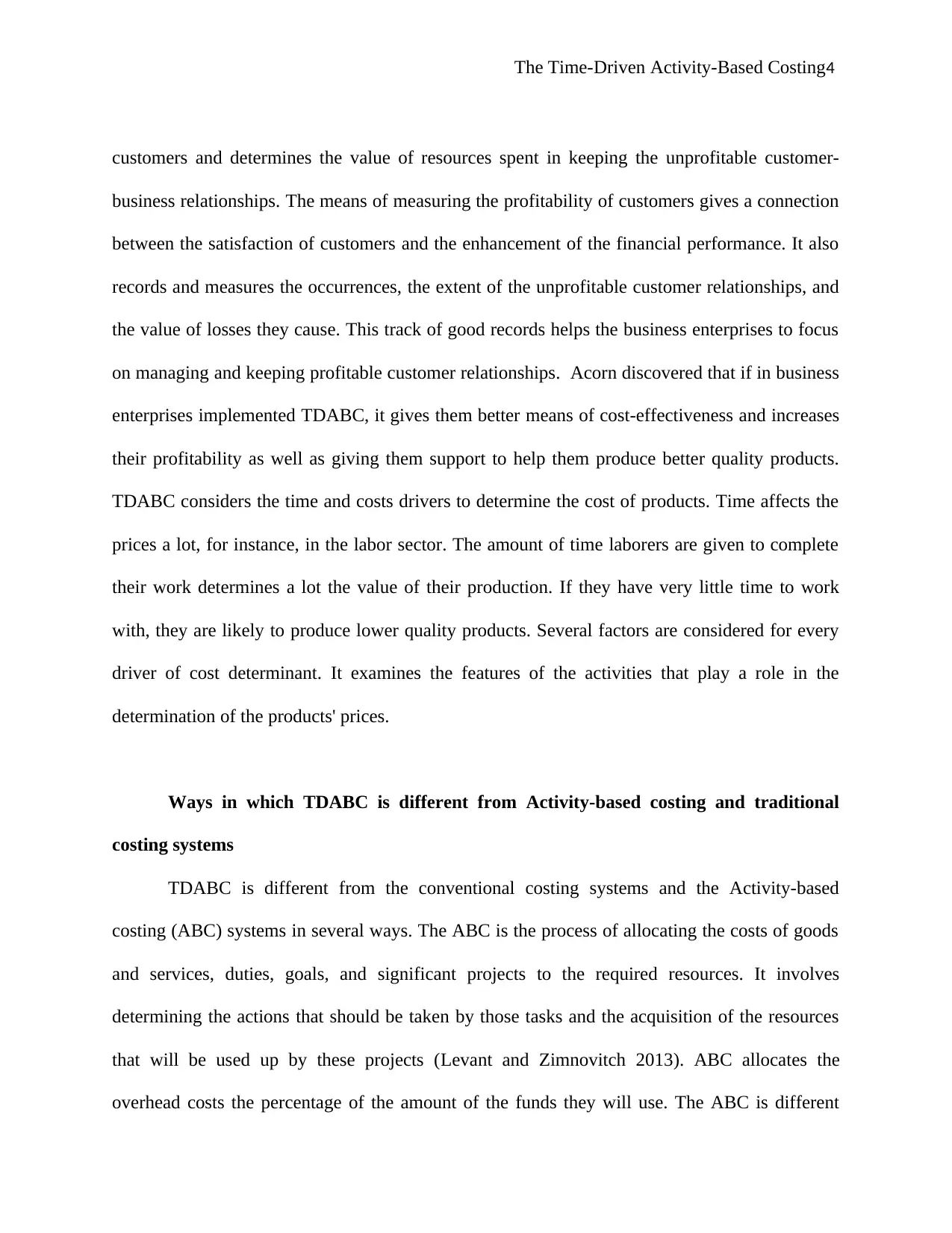
The Time-Driven Activity-Based Costing4
customers and determines the value of resources spent in keeping the unprofitable customer-
business relationships. The means of measuring the profitability of customers gives a connection
between the satisfaction of customers and the enhancement of the financial performance. It also
records and measures the occurrences, the extent of the unprofitable customer relationships, and
the value of losses they cause. This track of good records helps the business enterprises to focus
on managing and keeping profitable customer relationships. Acorn discovered that if in business
enterprises implemented TDABC, it gives them better means of cost-effectiveness and increases
their profitability as well as giving them support to help them produce better quality products.
TDABC considers the time and costs drivers to determine the cost of products. Time affects the
prices a lot, for instance, in the labor sector. The amount of time laborers are given to complete
their work determines a lot the value of their production. If they have very little time to work
with, they are likely to produce lower quality products. Several factors are considered for every
driver of cost determinant. It examines the features of the activities that play a role in the
determination of the products' prices.
Ways in which TDABC is different from Activity-based costing and traditional
costing systems
TDABC is different from the conventional costing systems and the Activity-based
costing (ABC) systems in several ways. The ABC is the process of allocating the costs of goods
and services, duties, goals, and significant projects to the required resources. It involves
determining the actions that should be taken by those tasks and the acquisition of the resources
that will be used up by these projects (Levant and Zimnovitch 2013). ABC allocates the
overhead costs the percentage of the amount of the funds they will use. The ABC is different
customers and determines the value of resources spent in keeping the unprofitable customer-
business relationships. The means of measuring the profitability of customers gives a connection
between the satisfaction of customers and the enhancement of the financial performance. It also
records and measures the occurrences, the extent of the unprofitable customer relationships, and
the value of losses they cause. This track of good records helps the business enterprises to focus
on managing and keeping profitable customer relationships. Acorn discovered that if in business
enterprises implemented TDABC, it gives them better means of cost-effectiveness and increases
their profitability as well as giving them support to help them produce better quality products.
TDABC considers the time and costs drivers to determine the cost of products. Time affects the
prices a lot, for instance, in the labor sector. The amount of time laborers are given to complete
their work determines a lot the value of their production. If they have very little time to work
with, they are likely to produce lower quality products. Several factors are considered for every
driver of cost determinant. It examines the features of the activities that play a role in the
determination of the products' prices.
Ways in which TDABC is different from Activity-based costing and traditional
costing systems
TDABC is different from the conventional costing systems and the Activity-based
costing (ABC) systems in several ways. The ABC is the process of allocating the costs of goods
and services, duties, goals, and significant projects to the required resources. It involves
determining the actions that should be taken by those tasks and the acquisition of the resources
that will be used up by these projects (Levant and Zimnovitch 2013). ABC allocates the
overhead costs the percentage of the amount of the funds they will use. The ABC is different
Paraphrase This Document
Need a fresh take? Get an instant paraphrase of this document with our AI Paraphraser

The Time-Driven Activity-Based Costing5
from the TDABC since it assigns the value of goods and services by relating them to their cost of
production whereas TDABC considers the time and cost drivers to determine the price of
products. ABC considers only a single factor in the determination of the value of goods whereas
TDABC considers several factors for every driver of cost determinant (Oleskow, Fertsch and
Golinska 2009). The traditional costing systems allocate the factory's overhead costs to the
products depending on the value of the resources used in the production. The overhead costs are
applied depending on the amount of the resources used in the output. The primary disadvantage
of the traditional costing system is that the overhead costs could go higher than the discrepancies
in resource allocation. This difference means that if the value of resources changes by a small
range, then there is a massive deviation in the overhead costs.
The ABC and the traditional costing systems estimate the costs of sales and the profit
margin separately for each product, unlike the TDABC which determines the specific
commodities which can earn a profit. It could be difficult to determine the profitable products
when the costs estimates are not precise (Szychta 2010). The traditional costing systems could
provide distorted prices of goods and services, especially when there is a mismatch between the
cost of activities and that of the resources. This mismatch in prices of commodities is different
with the TDABC in that it ensures an apparent record of the events and the cost of the products.
There are sporadic cases of distorted information. The TDABC was implemented to surmount
the ABC’s and the traditional costing systems’ shortcomings.
Is TDABC suitable for the client or not considers the time and cost drivers to
determine the cost of products
The TDABC is ideal for the client because of its numerous benefits. I will outline some
few case studies that were carried out to determine the relevance of successful implementation of
from the TDABC since it assigns the value of goods and services by relating them to their cost of
production whereas TDABC considers the time and cost drivers to determine the price of
products. ABC considers only a single factor in the determination of the value of goods whereas
TDABC considers several factors for every driver of cost determinant (Oleskow, Fertsch and
Golinska 2009). The traditional costing systems allocate the factory's overhead costs to the
products depending on the value of the resources used in the production. The overhead costs are
applied depending on the amount of the resources used in the output. The primary disadvantage
of the traditional costing system is that the overhead costs could go higher than the discrepancies
in resource allocation. This difference means that if the value of resources changes by a small
range, then there is a massive deviation in the overhead costs.
The ABC and the traditional costing systems estimate the costs of sales and the profit
margin separately for each product, unlike the TDABC which determines the specific
commodities which can earn a profit. It could be difficult to determine the profitable products
when the costs estimates are not precise (Szychta 2010). The traditional costing systems could
provide distorted prices of goods and services, especially when there is a mismatch between the
cost of activities and that of the resources. This mismatch in prices of commodities is different
with the TDABC in that it ensures an apparent record of the events and the cost of the products.
There are sporadic cases of distorted information. The TDABC was implemented to surmount
the ABC’s and the traditional costing systems’ shortcomings.
Is TDABC suitable for the client or not considers the time and cost drivers to
determine the cost of products
The TDABC is ideal for the client because of its numerous benefits. I will outline some
few case studies that were carried out to determine the relevance of successful implementation of

The Time-Driven Activity-Based Costing6
TDABC (Järvinen and Väätäjä 2018). I will then show its benefits and the benefits of using it for
TPG Telecom’s budgeting. A detailed was carried out to determine the success of its
implementation in several business enterprises. The study was carried out in many organizations
some of which were the medical centers and some business enterprises. TDABC was used to
determine the cost of treating men with the urologic and the prostatic condition. It was
implemented for all the inpatients and the outpatients who required specialized and primary care.
The experts worked on the detailed processes to determine the personal costs of urology tests at
the clinics (Kaplan et al. 2015). They discovered that the costs difference between the surgical
and the diagnosis models for treating the prostatic condition in men was reasonably large. The
TDABC implementation helped them to determine the costs factors to help them handle the
patients' disease in a way that was cost-effective.
Another case study was carried out in a furniture manufacturing firm which operated on
a small scale (Ganorkar et al. 2018). This article explains a methodology that researchers
described that could be used by small enterprises to adopt the TDABC system. The study showed
that overhead expenses such as the rent, maintenance fee, and power usage were assigned to the
final product (Gervais, Levant and Ducrocq 2010). The made the tracing of overhead costs
straightforward and manageable. It also made the calculation of related expenses very
manageable. It was, therefore, effortless to determine the profitable products and hence improve
their productivity. The results could help the firm make more strategic decisions and identify the
profitability opportunities.
Another research that was carried out by Anderson and Kaplan in the use of time factors
in determining the costs of goods (Anderson et al. 2008). Their goals were to manage expenses,
idle resources, and check for errors in budgeting. The model that they invented that was time-
TDABC (Järvinen and Väätäjä 2018). I will then show its benefits and the benefits of using it for
TPG Telecom’s budgeting. A detailed was carried out to determine the success of its
implementation in several business enterprises. The study was carried out in many organizations
some of which were the medical centers and some business enterprises. TDABC was used to
determine the cost of treating men with the urologic and the prostatic condition. It was
implemented for all the inpatients and the outpatients who required specialized and primary care.
The experts worked on the detailed processes to determine the personal costs of urology tests at
the clinics (Kaplan et al. 2015). They discovered that the costs difference between the surgical
and the diagnosis models for treating the prostatic condition in men was reasonably large. The
TDABC implementation helped them to determine the costs factors to help them handle the
patients' disease in a way that was cost-effective.
Another case study was carried out in a furniture manufacturing firm which operated on
a small scale (Ganorkar et al. 2018). This article explains a methodology that researchers
described that could be used by small enterprises to adopt the TDABC system. The study showed
that overhead expenses such as the rent, maintenance fee, and power usage were assigned to the
final product (Gervais, Levant and Ducrocq 2010). The made the tracing of overhead costs
straightforward and manageable. It also made the calculation of related expenses very
manageable. It was, therefore, effortless to determine the profitable products and hence improve
their productivity. The results could help the firm make more strategic decisions and identify the
profitability opportunities.
Another research that was carried out by Anderson and Kaplan in the use of time factors
in determining the costs of goods (Anderson et al. 2008). Their goals were to manage expenses,
idle resources, and check for errors in budgeting. The model that they invented that was time-
⊘ This is a preview!⊘
Do you want full access?
Subscribe today to unlock all pages.

Trusted by 1+ million students worldwide
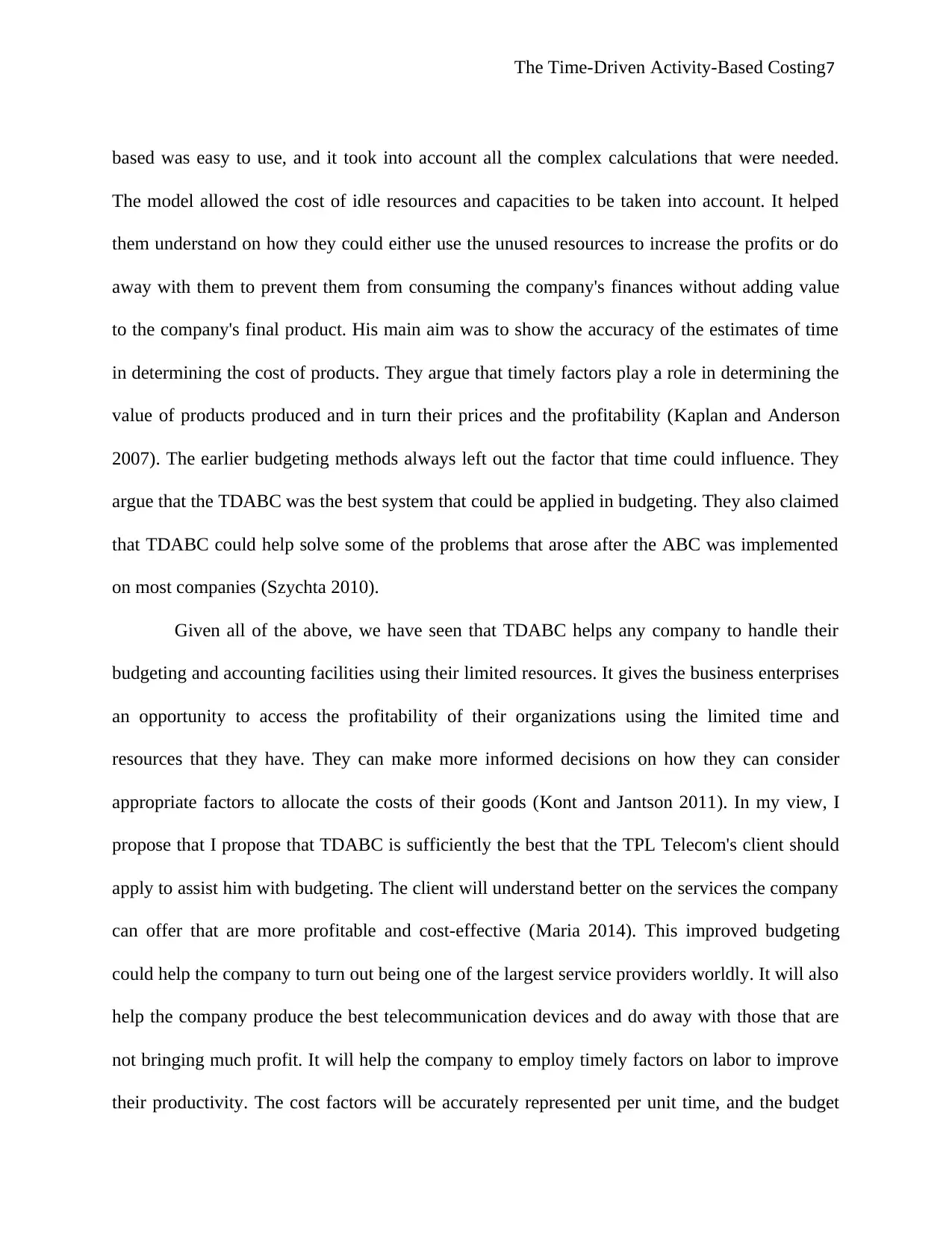
The Time-Driven Activity-Based Costing7
based was easy to use, and it took into account all the complex calculations that were needed.
The model allowed the cost of idle resources and capacities to be taken into account. It helped
them understand on how they could either use the unused resources to increase the profits or do
away with them to prevent them from consuming the company's finances without adding value
to the company's final product. His main aim was to show the accuracy of the estimates of time
in determining the cost of products. They argue that timely factors play a role in determining the
value of products produced and in turn their prices and the profitability (Kaplan and Anderson
2007). The earlier budgeting methods always left out the factor that time could influence. They
argue that the TDABC was the best system that could be applied in budgeting. They also claimed
that TDABC could help solve some of the problems that arose after the ABC was implemented
on most companies (Szychta 2010).
Given all of the above, we have seen that TDABC helps any company to handle their
budgeting and accounting facilities using their limited resources. It gives the business enterprises
an opportunity to access the profitability of their organizations using the limited time and
resources that they have. They can make more informed decisions on how they can consider
appropriate factors to allocate the costs of their goods (Kont and Jantson 2011). In my view, I
propose that I propose that TDABC is sufficiently the best that the TPL Telecom's client should
apply to assist him with budgeting. The client will understand better on the services the company
can offer that are more profitable and cost-effective (Maria 2014). This improved budgeting
could help the company to turn out being one of the largest service providers worldly. It will also
help the company produce the best telecommunication devices and do away with those that are
not bringing much profit. It will help the company to employ timely factors on labor to improve
their productivity. The cost factors will be accurately represented per unit time, and the budget
based was easy to use, and it took into account all the complex calculations that were needed.
The model allowed the cost of idle resources and capacities to be taken into account. It helped
them understand on how they could either use the unused resources to increase the profits or do
away with them to prevent them from consuming the company's finances without adding value
to the company's final product. His main aim was to show the accuracy of the estimates of time
in determining the cost of products. They argue that timely factors play a role in determining the
value of products produced and in turn their prices and the profitability (Kaplan and Anderson
2007). The earlier budgeting methods always left out the factor that time could influence. They
argue that the TDABC was the best system that could be applied in budgeting. They also claimed
that TDABC could help solve some of the problems that arose after the ABC was implemented
on most companies (Szychta 2010).
Given all of the above, we have seen that TDABC helps any company to handle their
budgeting and accounting facilities using their limited resources. It gives the business enterprises
an opportunity to access the profitability of their organizations using the limited time and
resources that they have. They can make more informed decisions on how they can consider
appropriate factors to allocate the costs of their goods (Kont and Jantson 2011). In my view, I
propose that I propose that TDABC is sufficiently the best that the TPL Telecom's client should
apply to assist him with budgeting. The client will understand better on the services the company
can offer that are more profitable and cost-effective (Maria 2014). This improved budgeting
could help the company to turn out being one of the largest service providers worldly. It will also
help the company produce the best telecommunication devices and do away with those that are
not bringing much profit. It will help the company to employ timely factors on labor to improve
their productivity. The cost factors will be accurately represented per unit time, and the budget
Paraphrase This Document
Need a fresh take? Get an instant paraphrase of this document with our AI Paraphraser

The Time-Driven Activity-Based Costing8
will appear more organized and accurate (Dalci, Tanis and Kosan 2010). The TDABC will help
the company use their available minimum resources to maximize their profits and improve
customer-company relationships to increase the market demand for their profits. It will also help
the company to use cost-effective methods to increase the quality of their products by improving
their time-based labor and resources. It will also help the company take into account every factor
that contributes to the cost of production, and assist it how it can reduce the cost while
maximizing the profit.
Conclusion
Given the above facts, it is important for all the business enterprises and other companies
to implement the TDABC in their budgeting sector because it will help them identify the
profitable opportunities and customers as well as determining the proper pricing of their
products. It will help them identify the unprofitable business situations and evade them. The
TDABC has more merits than demerits, and so all companies dealing with budgeting and
accounting departments should consider implementing the new model.
will appear more organized and accurate (Dalci, Tanis and Kosan 2010). The TDABC will help
the company use their available minimum resources to maximize their profits and improve
customer-company relationships to increase the market demand for their profits. It will also help
the company to use cost-effective methods to increase the quality of their products by improving
their time-based labor and resources. It will also help the company take into account every factor
that contributes to the cost of production, and assist it how it can reduce the cost while
maximizing the profit.
Conclusion
Given the above facts, it is important for all the business enterprises and other companies
to implement the TDABC in their budgeting sector because it will help them identify the
profitable opportunities and customers as well as determining the proper pricing of their
products. It will help them identify the unprofitable business situations and evade them. The
TDABC has more merits than demerits, and so all companies dealing with budgeting and
accounting departments should consider implementing the new model.
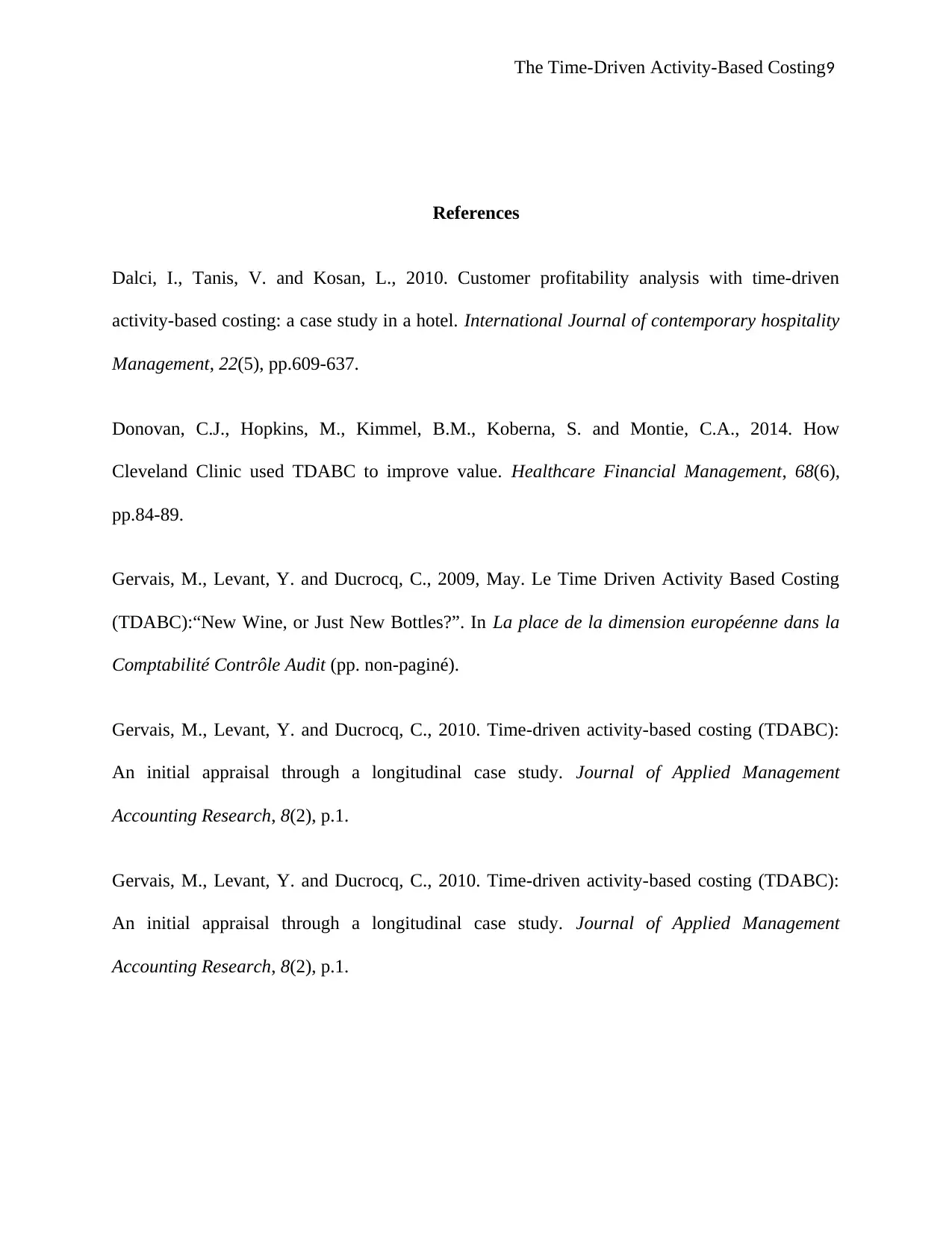
The Time-Driven Activity-Based Costing9
References
Dalci, I., Tanis, V. and Kosan, L., 2010. Customer profitability analysis with time-driven
activity-based costing: a case study in a hotel. International Journal of contemporary hospitality
Management, 22(5), pp.609-637.
Donovan, C.J., Hopkins, M., Kimmel, B.M., Koberna, S. and Montie, C.A., 2014. How
Cleveland Clinic used TDABC to improve value. Healthcare Financial Management, 68(6),
pp.84-89.
Gervais, M., Levant, Y. and Ducrocq, C., 2009, May. Le Time Driven Activity Based Costing
(TDABC):“New Wine, or Just New Bottles?”. In La place de la dimension européenne dans la
Comptabilité Contrôle Audit (pp. non-paginé).
Gervais, M., Levant, Y. and Ducrocq, C., 2010. Time-driven activity-based costing (TDABC):
An initial appraisal through a longitudinal case study. Journal of Applied Management
Accounting Research, 8(2), p.1.
Gervais, M., Levant, Y. and Ducrocq, C., 2010. Time-driven activity-based costing (TDABC):
An initial appraisal through a longitudinal case study. Journal of Applied Management
Accounting Research, 8(2), p.1.
References
Dalci, I., Tanis, V. and Kosan, L., 2010. Customer profitability analysis with time-driven
activity-based costing: a case study in a hotel. International Journal of contemporary hospitality
Management, 22(5), pp.609-637.
Donovan, C.J., Hopkins, M., Kimmel, B.M., Koberna, S. and Montie, C.A., 2014. How
Cleveland Clinic used TDABC to improve value. Healthcare Financial Management, 68(6),
pp.84-89.
Gervais, M., Levant, Y. and Ducrocq, C., 2009, May. Le Time Driven Activity Based Costing
(TDABC):“New Wine, or Just New Bottles?”. In La place de la dimension européenne dans la
Comptabilité Contrôle Audit (pp. non-paginé).
Gervais, M., Levant, Y. and Ducrocq, C., 2010. Time-driven activity-based costing (TDABC):
An initial appraisal through a longitudinal case study. Journal of Applied Management
Accounting Research, 8(2), p.1.
Gervais, M., Levant, Y. and Ducrocq, C., 2010. Time-driven activity-based costing (TDABC):
An initial appraisal through a longitudinal case study. Journal of Applied Management
Accounting Research, 8(2), p.1.
⊘ This is a preview!⊘
Do you want full access?
Subscribe today to unlock all pages.

Trusted by 1+ million students worldwide
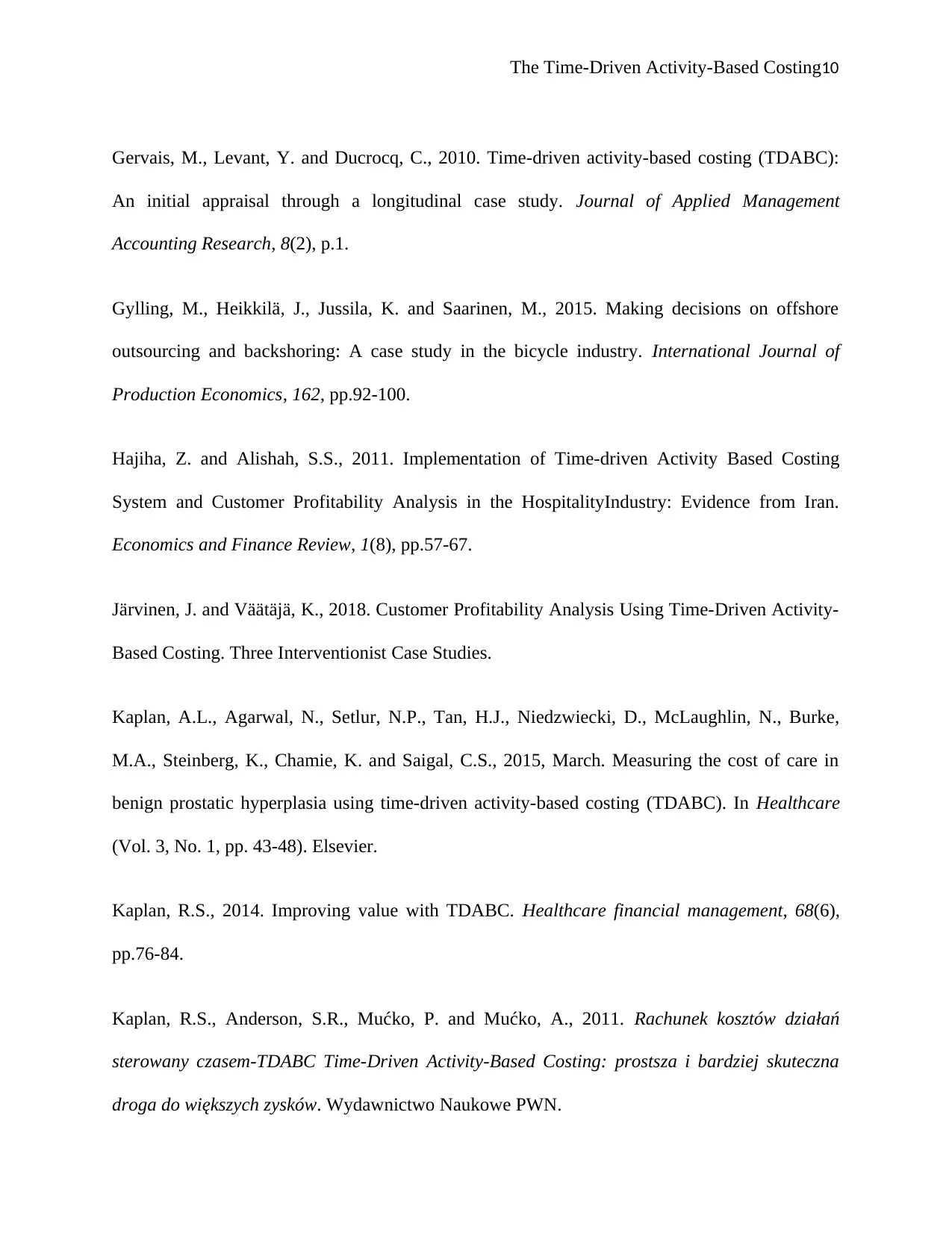
The Time-Driven Activity-Based Costing10
Gervais, M., Levant, Y. and Ducrocq, C., 2010. Time-driven activity-based costing (TDABC):
An initial appraisal through a longitudinal case study. Journal of Applied Management
Accounting Research, 8(2), p.1.
Gylling, M., Heikkilä, J., Jussila, K. and Saarinen, M., 2015. Making decisions on offshore
outsourcing and backshoring: A case study in the bicycle industry. International Journal of
Production Economics, 162, pp.92-100.
Hajiha, Z. and Alishah, S.S., 2011. Implementation of Time-driven Activity Based Costing
System and Customer Profitability Analysis in the HospitalityIndustry: Evidence from Iran.
Economics and Finance Review, 1(8), pp.57-67.
Järvinen, J. and Väätäjä, K., 2018. Customer Profitability Analysis Using Time-Driven Activity-
Based Costing. Three Interventionist Case Studies.
Kaplan, A.L., Agarwal, N., Setlur, N.P., Tan, H.J., Niedzwiecki, D., McLaughlin, N., Burke,
M.A., Steinberg, K., Chamie, K. and Saigal, C.S., 2015, March. Measuring the cost of care in
benign prostatic hyperplasia using time-driven activity-based costing (TDABC). In Healthcare
(Vol. 3, No. 1, pp. 43-48). Elsevier.
Kaplan, R.S., 2014. Improving value with TDABC. Healthcare financial management, 68(6),
pp.76-84.
Kaplan, R.S., Anderson, S.R., Mućko, P. and Mućko, A., 2011. Rachunek kosztów działań
sterowany czasem-TDABC Time-Driven Activity-Based Costing: prostsza i bardziej skuteczna
droga do większych zysków. Wydawnictwo Naukowe PWN.
Gervais, M., Levant, Y. and Ducrocq, C., 2010. Time-driven activity-based costing (TDABC):
An initial appraisal through a longitudinal case study. Journal of Applied Management
Accounting Research, 8(2), p.1.
Gylling, M., Heikkilä, J., Jussila, K. and Saarinen, M., 2015. Making decisions on offshore
outsourcing and backshoring: A case study in the bicycle industry. International Journal of
Production Economics, 162, pp.92-100.
Hajiha, Z. and Alishah, S.S., 2011. Implementation of Time-driven Activity Based Costing
System and Customer Profitability Analysis in the HospitalityIndustry: Evidence from Iran.
Economics and Finance Review, 1(8), pp.57-67.
Järvinen, J. and Väätäjä, K., 2018. Customer Profitability Analysis Using Time-Driven Activity-
Based Costing. Three Interventionist Case Studies.
Kaplan, A.L., Agarwal, N., Setlur, N.P., Tan, H.J., Niedzwiecki, D., McLaughlin, N., Burke,
M.A., Steinberg, K., Chamie, K. and Saigal, C.S., 2015, March. Measuring the cost of care in
benign prostatic hyperplasia using time-driven activity-based costing (TDABC). In Healthcare
(Vol. 3, No. 1, pp. 43-48). Elsevier.
Kaplan, R.S., 2014. Improving value with TDABC. Healthcare financial management, 68(6),
pp.76-84.
Kaplan, R.S., Anderson, S.R., Mućko, P. and Mućko, A., 2011. Rachunek kosztów działań
sterowany czasem-TDABC Time-Driven Activity-Based Costing: prostsza i bardziej skuteczna
droga do większych zysków. Wydawnictwo Naukowe PWN.
Paraphrase This Document
Need a fresh take? Get an instant paraphrase of this document with our AI Paraphraser
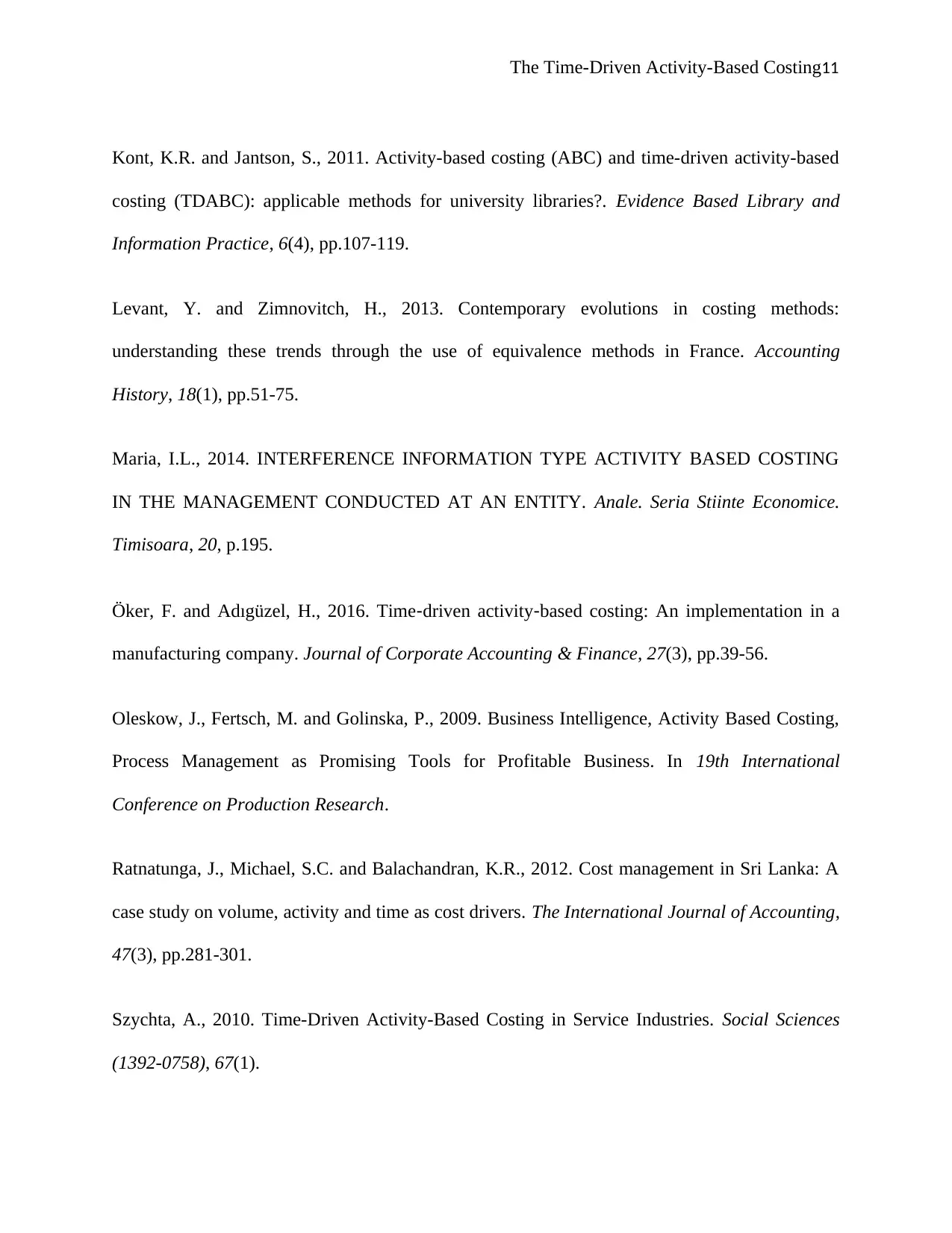
The Time-Driven Activity-Based Costing11
Kont, K.R. and Jantson, S., 2011. Activity-based costing (ABC) and time-driven activity-based
costing (TDABC): applicable methods for university libraries?. Evidence Based Library and
Information Practice, 6(4), pp.107-119.
Levant, Y. and Zimnovitch, H., 2013. Contemporary evolutions in costing methods:
understanding these trends through the use of equivalence methods in France. Accounting
History, 18(1), pp.51-75.
Maria, I.L., 2014. INTERFERENCE INFORMATION TYPE ACTIVITY BASED COSTING
IN THE MANAGEMENT CONDUCTED AT AN ENTITY. Anale. Seria Stiinte Economice.
Timisoara, 20, p.195.
Öker, F. and Adıgüzel, H., 2016. Time‐driven activity‐based costing: An implementation in a
manufacturing company. Journal of Corporate Accounting & Finance, 27(3), pp.39-56.
Oleskow, J., Fertsch, M. and Golinska, P., 2009. Business Intelligence, Activity Based Costing,
Process Management as Promising Tools for Profitable Business. In 19th International
Conference on Production Research.
Ratnatunga, J., Michael, S.C. and Balachandran, K.R., 2012. Cost management in Sri Lanka: A
case study on volume, activity and time as cost drivers. The International Journal of Accounting,
47(3), pp.281-301.
Szychta, A., 2010. Time-Driven Activity-Based Costing in Service Industries. Social Sciences
(1392-0758), 67(1).
Kont, K.R. and Jantson, S., 2011. Activity-based costing (ABC) and time-driven activity-based
costing (TDABC): applicable methods for university libraries?. Evidence Based Library and
Information Practice, 6(4), pp.107-119.
Levant, Y. and Zimnovitch, H., 2013. Contemporary evolutions in costing methods:
understanding these trends through the use of equivalence methods in France. Accounting
History, 18(1), pp.51-75.
Maria, I.L., 2014. INTERFERENCE INFORMATION TYPE ACTIVITY BASED COSTING
IN THE MANAGEMENT CONDUCTED AT AN ENTITY. Anale. Seria Stiinte Economice.
Timisoara, 20, p.195.
Öker, F. and Adıgüzel, H., 2016. Time‐driven activity‐based costing: An implementation in a
manufacturing company. Journal of Corporate Accounting & Finance, 27(3), pp.39-56.
Oleskow, J., Fertsch, M. and Golinska, P., 2009. Business Intelligence, Activity Based Costing,
Process Management as Promising Tools for Profitable Business. In 19th International
Conference on Production Research.
Ratnatunga, J., Michael, S.C. and Balachandran, K.R., 2012. Cost management in Sri Lanka: A
case study on volume, activity and time as cost drivers. The International Journal of Accounting,
47(3), pp.281-301.
Szychta, A., 2010. Time-Driven Activity-Based Costing in Service Industries. Social Sciences
(1392-0758), 67(1).
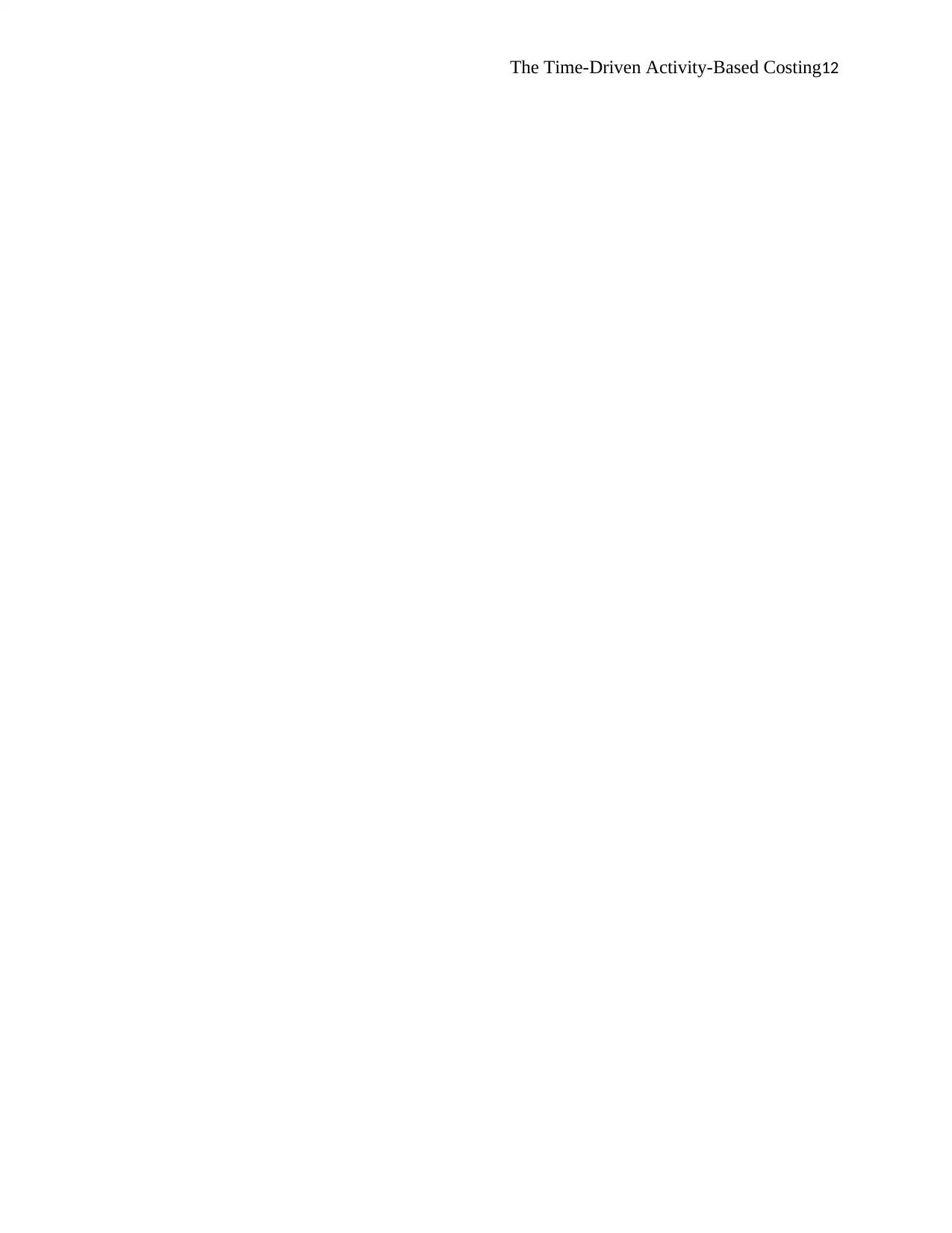
The Time-Driven Activity-Based Costing12
⊘ This is a preview!⊘
Do you want full access?
Subscribe today to unlock all pages.

Trusted by 1+ million students worldwide
1 out of 12
Related Documents
Your All-in-One AI-Powered Toolkit for Academic Success.
+13062052269
info@desklib.com
Available 24*7 on WhatsApp / Email
![[object Object]](/_next/static/media/star-bottom.7253800d.svg)
Unlock your academic potential
Copyright © 2020–2025 A2Z Services. All Rights Reserved. Developed and managed by ZUCOL.





